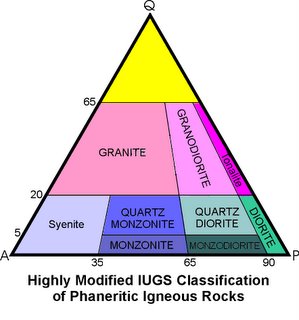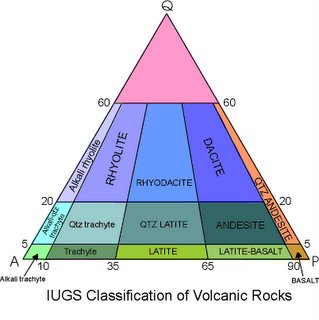IUGS classification


Igneous rocks are classified on the basis of mineralogy, chemistry, and texture. Texture is used to subdivide igneous rocks into two major groups: (1) the plutonic rocks, with mineral grain sizes that are visible to the naked eye, and (2) the volcanic rocks, which are usually too fine-grained or glassy for their mineral composition to be observed without the use of a petrographic microscope. This is largely a genetic classification based on the depth of origin of the rock (volcanic at or near the surface, and plutonic at depth). Remember that porphyritic rocks have spent time in both worlds.
The plotting of rock modes on these triangular diagrams is simpler than it may appear. The three components, Q (quartz) + A (alkali (Na-K) feldspar) + P (plagioclase), are recalculated from the mode to sum to 100 percent. Each component is represented by the corners of the equilateral triangle, the length of whose sides are divided into 100 equal parts. Any composition plotting at a corner, therefore, has a mode of 100 percent of the corresponding component. Any point on the sides of the triangle represents a mode composed of the two adjacent corner components. For example, a rock with 60 percent Q and 40 percent A will plot on the QA side at a location 60 percent of the distance from A to Q. A rock containing all three components will plot within the triangle. Since the sides of the triangle are divided into 100 parts, a rock having a mode of 20 percent Q and 80 percent A + P (in unknown proportions for the moment) will plot on the line that parallels the AP side and lies 20 percent of the distance toward Q from the side AP. If this same rock has 30 percent P and 50 percent A, the rock mode will plot at the intersection of the 20 percent Q line described above, with a line paralleling the QA side at a distance 30 percent toward P from the QA side. The third intersecting line for the point is necessarily the line paralleling the QP side at 50 percent of the distance from the side QP toward A. A rock with 25 percent Q, 35 percent P, and 40 percent A plots in the granite field, whereas one with 25 percent Q, 60 percent P, and 15 percent A plots in the granodiorite field. The latter is close to the average composition of the continental crust of the Earth.


0 Comments:
Post a Comment
<< Home